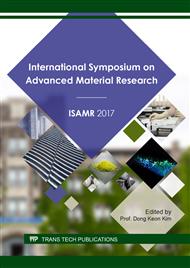[1]
C. Cosenza, L. Fratini, A. Pasta, et al. Damage and fracture study of cold extrusion dies, Eng. Fract. Mech. 71(7-8) (2004) 1021-1033.
DOI: 10.1016/s0013-7944(03)00154-1
Google Scholar
[2]
M. Geiger, B. Falk. Prediction of service life and failure probability of cold forging tools. Manuf. Tech. 50(1) (2001) 173-176.
DOI: 10.1016/s0007-8506(07)62098-8
Google Scholar
[3]
F. S. Chen, P. Y. Lee, M. C. Yeh. Thermal reactive deposition coating of chromium carbide on die steel in a fluidized bed furnace. Mater. Chem. Phys. 53(1) (1998) 19-27.
DOI: 10.1016/s0254-0584(97)02048-8
Google Scholar
[4]
X. S. Fan, Z. G. Yang, C. Zang, et al. Evaluation of vanadium carbide coatings on AISI H13 obtained by thermo-reactive deposition/diffusion technique. Surf. Coat. Tech. 205(2) (2010) 641-646.
DOI: 10.1016/j.surfcoat.2010.07.065
Google Scholar
[5]
M. Biesuz, V. M. Sglavo. Chromium and vanadium carbide and nitride coatings obtained by TRD techniques on UNI 42CrMoS4 (AISI 4140) steel. Surf. Coat. Tech. 286 (2016) 319-326.
DOI: 10.1016/j.surfcoat.2015.12.063
Google Scholar
[6]
C. K. N. Oliveira, R. M. Munoz Riofano, L. C. Casteletti. Micro-abrasive wear test of niobium carbide layers produced on AISI H13 and M2 steels, Surf. Coat. Tech. 200(16-17) (2006) 5140-5144.
DOI: 10.1016/j.surfcoat.2005.05.037
Google Scholar
[7]
F. E. Castillejo, D. M. Marulanda, J. J. Olaya, et al. Wear and corrosion resistance of niobium–chromium carbide coatings on AISI D2 produced through TRD, Surf. Coat. Tech. 254 (2014) 104-111.
DOI: 10.1016/j.surfcoat.2014.05.069
Google Scholar
[8]
U. Sen. Wear properties of niobium carbide coatings performed by pack method on AISI 1040 steel, Thin Solid Film. 483(1-2) (2005) 152-157.
DOI: 10.1016/j.tsf.2005.01.008
Google Scholar
[9]
Q. K. Sun, H. C. Wang, H. J. Wang, Research on niobium carbide coating process by TD technique in salt bath and properties of coating, Mater. Heat Treat. 41(4) (2012) 181-184.
Google Scholar
[10]
J. W. Lee, J. G. Duh, S. Y. Tsai. Corrosion resistance and microstructural evaluation of the chromized coating process in a dual phase Fe-Mn-Al-Cr alloy. Surf. Coat. Tech. 153(1) (2002) 59-66.
DOI: 10.1016/s0257-8972(01)01546-8
Google Scholar
[11]
B. H. Rabin, I. Shiota. Functionally gradient materials, MRS Bull. 20(1) (1995) 14-18.
DOI: 10.1557/s0883769400048855
Google Scholar
[12]
Z. J. Shan, Z. G. Pang, F. Q. Luo, et al. Kinetics of V(N, C) and Nb(N, C) coatings produced by V–Nb–RE deposition technique, Surf. Coat. Tech. 206(19-20) (2012) 4322-4327.
DOI: 10.1016/j.surfcoat.2012.04.057
Google Scholar
[13]
F. S. Chen, K. L. Wang, The kinetics and mechanism of multi-component diffusion on AISI 1045 steel, Surf. Coat. Tech. 115(2-3) (1999) 239-248.
DOI: 10.1016/s0257-8972(99)00179-6
Google Scholar
[14]
H. J. Wang, W. J. Zhang, H. C. Wang, et al. The agent of TD salt bath Nb-Cr co-diffusion treatment and its application, in Chinese CN201310037971. 9, 2013-05-15.
Google Scholar


